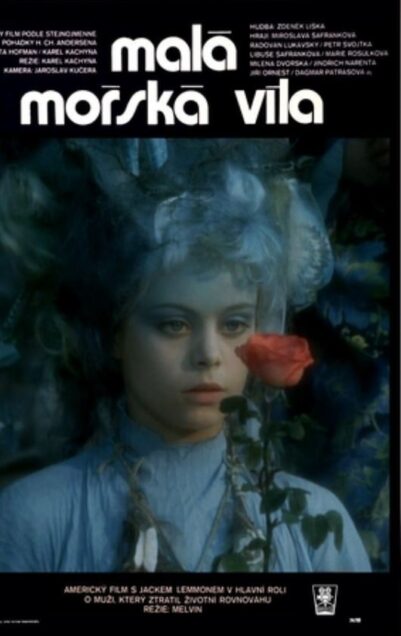This is arguably the finest-ever live action filming of Hans Christian Andersen’s 1837 fairy tale, a Czech production from 1976 (the same year RUSALOCHKA, a Russian-made adaptation of Andersen’s tale, was released) directed by the great Karel Kachyňa (1924-2004). Kachyňa was a guiding light of the Czech New Wave movement of the 1960s, with politically-minded provocations like THE NUN’S NIGHT (Noc nevěsty; 1967) and THE EAR (Ucho; 1970). But after the “normalization” period in Czechoslovakia that followed its Soviet-led 1968 invasion those films were banned, with Kachyňa obliged to focus on children’s fare, of which THE LITTLE MERMAID (Malá mořská víla) is the foremost example.
Christian Andersen’s 1837 fairy tale, a Czech production from 1976 (the same year RUSALOCHKA, a Russian-made adaptation of Andersen’s tale, was released) directed by the great Karel Kachyňa (1924-2004). Kachyňa was a guiding light of the Czech New Wave movement of the 1960s, with politically-minded provocations like THE NUN’S NIGHT (Noc nevěsty; 1967) and THE EAR (Ucho; 1970). But after the “normalization” period in Czechoslovakia that followed its Soviet-led 1968 invasion those films were banned, with Kachyňa obliged to focus on children’s fare, of which THE LITTLE MERMAID (Malá mořská víla) is the foremost example.
A pair of mermaid girls—“Merpeople”—live in an undersea kingdom ruled by their father the Sea King (Radovan Lukavský), where the girls play and sing songs (how they’re able to do so under water is left unexplained). One of them is the title character (Miroslava Šafránková), an enormously pretty young woman who wears an elaborate silver headdress and very heavy make-up. She’s her father’s favorite child, and directly in line to inherit his throne, her mother having disappeared years earlier.
During a trip to the surface the Little Mermaid sees a handsome prince (Petr Svojtka) killed in a ship wreck, and promptly revives him (with the words “Wake up! Humans mustn’t sleep in the sea!”). She immediately falls in love with the prince, but he’s set to marry a young brunette princess (Libuše Šafránková, a.k.a. Miroslava’s sister) he mistakenly believes saved his life.
The Little Mermaid implores the Sea Witch (Milena Dvorská) to use her witchery to make the prince fall in love with her. This, however, means the Little Mermaid will have to endure stabbing pain in her feet with every step she takes, become a mute red-headed human and accept that if the prince marries someone else the Little Mermaid will end up heartbroken and turned to sea foam. She agrees and is promptly ejected onto a beach, where the prince finds her and carries her back to his palace. The prince enjoys the Little Mermaid’s company, and his affections are enhanced when she picks multiple pearls out of an oyster shell and creates a seafood bounty for the local fishermen. The prince, however, is still set to marry the brunette princess. The only way for the Little Mermaid to win back her beloved is to kill the prince with a magic dagger bequeathed by her fellow Merpeople. Can she go through with the killing? And might she be following the doomed path taken by her lost-lost mother?
The Merpeople of this film look pretty silly, and the stage-bound underwater scenes (in which water is denoted by hazy lenses) are not well matched with the location photography of the aboveground action—and nor are the primitive model effects ever too convincing. But the film has a wistful and poetic atmosphere, facilitated by a subtle and unobtrusive score, a judicious use of slow motion and impeccably designed scenery (billowing drapes, etc.) to go along with Kachyňa’s wizardly visual sense.
Plus, Kachyňa keeps the original fairy tale’s darker edges intact (something neither of Disney’s adaptations did). The finale, in fact, is much grimmer than that of the Hans Christian Andersen original (which softened the Little Mermaid’s bleak fate with an optimistic epilogue), and can be read as a despairing commentary on unjust rule (which in this case forces one half of a star-crossed couple to live in ignorance of the true nature of his affections and leaves the other unable to properly express herself) that would appear to be fully in line with Kachyňa’s deeply held political beliefs.
Vital Statistics
THE LITTLE MERMAID (Malá mořská víla)
Filmové studio Barrandov
Director: Karel Kachyňa
Screenplay: Ota Hofman, Karel Kachyňa
Cinematography: Jaroslav Kučera
Editing: Miroslav Hájek
Cast: Miroslava Šafránková, Radovan Lukavský, Petr Svojtka, Libuše Šafránková, Marie Rosůlková, Milena Dvorská, Jiří Ornest, Dagmar Patrasová
